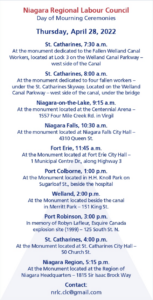In 1984, the Canadian Labour Congress established April 28th as the National Day of Mourning in Canada to remember and honour those who have died, been injured or suffered illness in the workplace.
The date was chosen in 1984, when the Canadian Labour Congress proclaimed the Day to coincide with the 70th anniversary of the day the first Ontario Worker’s Compensation Act was approved by the government (1914). The Day of Mourning was enshrined in national legislation by an Act of Parliament on February 1, 1991.
The Day of Mourning, also known as Workers’ Memorial Day, is officially recognized in about 100 countries worldwide.
Canadian flags on Parliament Hill and at Queen’s Park fly at half-mast on April 28th. The day is traditionally marked in many ways including holding public ceremonies, wearing black and yellow ribbons, lighting candles, observing a moment of silence at 11:00 a.m. and sharing stories about how workplace tragedies have touched peoples’ lives.
In Niagara, memorials are being held by the Niagara Region Labour Council:
Important steps to filing a successful WSIB Claim:
WSIB Legislative changes and employers’ challenges to workplace injuries are not always in the best interest of injured workers. Not following proper procedures after suffering a work related injury/illness can lead to WSIB claim denial and a delay to access of the necessary medical treatment to ensure complete recover.
Immediate medical attention is the key!
Many injured workers have had lost time claims denied due to the fact that an accident report was not submitted in a timely fashion (usually in the first 24 hours post-accident) by a certified healthcare professional such as; a family doctor, ER physician, or walk-in clinic doctor. Simply reporting an injury to your supervision or visiting the plant medical department does not constitute an accident report being submitted to WSIB. If you can’t see you family doctor right away, it is advisable to seek immediate medical attention by way of an attending physician at the hospital emergency room or a walk-in clinic. It is the attending physician’s responsibility to fill out a WSIB Form 8 which should include OBJECTIVE PHYSICAL FINDINGS related to your injury diagnosis. Ask for a copy. It is always a good idea to follow up with your own GP if your first medical attention was elsewhere. Your personal physician should also submit medical information to the WSIB through the appropriate forms.
The accident employer has responsibilities in the event of an accident which include; providing transportation to the appropriate medical facility and payment of wages for the remainder of your shift. The employer is then obliged to send a Form 7 to WSIB and must provide a copy to the injured worker.
Following your accident, the employer can request a Functional Abilities Form (FAF) from your treating physician in order to determine what modified work/light duties they can offer you. You are obliged under WSIB legislation to co-operate with your employer in an early and safe return to work plan as long as the modified duties offered are within the physical restrictions outlined in the FAF.
When the employer offers modified work to you after an injury, without having had the opportunity to seek medical attention from an attending physician, tell them you will gladly accept modified work when your doctor has completed an FAF to determine what medical restrictions, if any, you would have that would enable the company to offer you meaningful modified work within your medical restrictions. Working outside of your medical restrictions is unsafe as it can lead to further injury and can be refused.
An injured worker would be well advised to request from the initial attending physician, not only a copy of the completed Form 8 (accident report) containing COMPLETE OBJECTIVE MEDICAL FINDINGS, but also a completed FAF. If the attending physician is unable to provide you with an FAF, book a follow-up appointment with your personal physician as soon as possible and have him/her assess and complete the FAF form. You can then provide the employer with this completed FAF so they may consider your health needs and limitations when determining and assigning a modified work assignment that will not cause further injury.
Once your injury has been reported to the WSIB due to the filing of Forms 7 and 8, the WSIB will assign your claim to a case manager who will mail the injured worker a Form 6 to complete and return to the WSIB. Upon receiving the Form 6, we suggest you bring this form, along with any medical reports to the Union Hall for assistance in filling it out.
For Your Information:
WSIB Operational Policy requires case managers to use the Five Point Check System to rule on initial entitlement. An allowable claim must have the following five points:
1. An employer
2. A worker
3. Personal Work Related Injury
4. Proof of Accident which may include witnesses
5. Compatibility of diagnosis to accident or disablement history (extremely important)
Note: If your WSIB claim is denied, contact the Local Union offices for assistance.
A WORKER’S GUIDE
TO REPORTING A WORKPLACE INJURY/ILLNESS
SEEK IMMEDIATE MEDICAL ATTENTION
First aid, Family Doctor, Clinic or Hospital Emergency Dept.
REPORT IMMEDIATELY
Report all workplace injuries/illnesses to your employer
Reporting a minor injury can help prevent future injuries
SEEK ASSISTANCE
Consult your workplace/Local Union Representative
to determine next steps, including filing a Worker’s Comp Report
DOCUMENTATION
Obtain copies of all documents
Including employers’, workers’ and doctors’ reports
CO-OPERATION IN AN EARLY & SAFE RETURN TO WORK PROGRAM
Seek assistance from your workplace/Local Union Representative
unifor.org/healthandsafety
Stay safe.
In solidarity,
Jordan Lennox, President
Unifor Local 199

